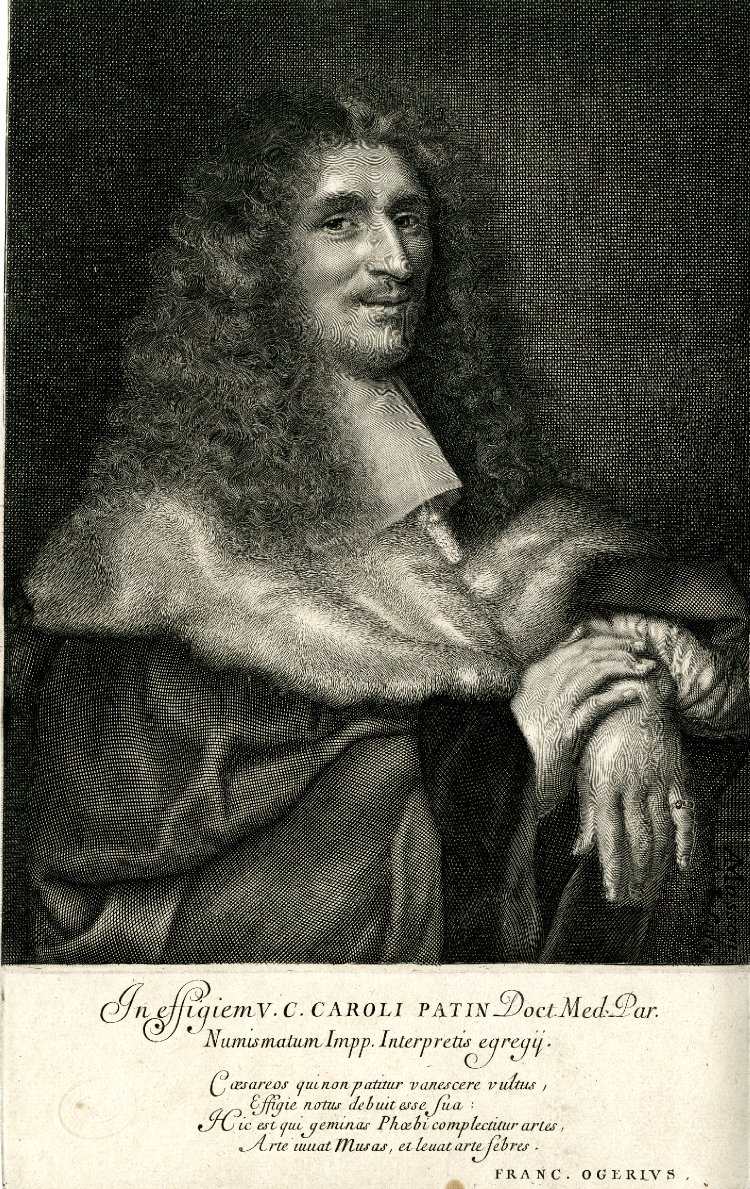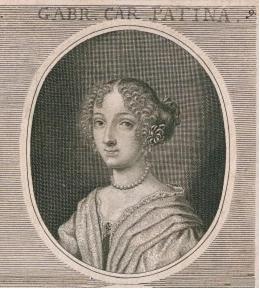|
Madeleine Patin
Madeleine Patin (c.1643 – 28 September 1722), born Madeleine Hommetz, was a French moralist author. The wife of medical doctor and numismatist Charles Patin, and daughter of medical doctor and letter writer Guy Patin, Madeleine Patin wrote philosophical and moral reflections. This genre was popular in Europe during the period, and was one to which French writers such as Jean-Jacques Rousseau made contributions. She published ''Christian and Moral Reflections on the Epistles of St. Paul'' in 1680, which she dedicated to Empress Eleanora of Austria. This work is still included in published anthologies today. She was made a member of the Galileiana Academy of Arts and Science, as were her husband and their two daughters, Charlotte-Catherine Patin, Charlotte-Catherine and Gabrielle-Charlotte Patin, Gabrielle-Charlotte. She was also made a member of the Academy of Ricovrati learned society of Padua, Italy. See also *French literature *17th-century French literature References< ... [...More Info...] [...Related Items...] OR: [Wikipedia] [Google] [Baidu] |
French Moralist
In French literature, the moralists (french: moralistes) were a tradition of secular writers who described "personal, social and political conduct", typically through maxims. The tradition is associated with the salons of the ''Ancien Régime'' from the 16th through the 18th centuries. The tradition begins with the ''Essais'' of Michel de Montaigne (1580), but its heyday was the late 17th century.Ian MacLean, "Moralistes", ''Routledge Encyclopedia of Philosophy'' (Taylor and Francis, 1998), . Although the moralists wrote essays and pen-portraits, their preferred genre was the maxim. These were short abstract statements devoid of context, often containing paradoxes and always designed to shock or surprise. The moralists aimed for objective and impartial observation freed from the preconceptions of their day. Their approach was never systematic. The four principal moralists and their main works are: * François de La Rochefoucauld, ''Réflexions ou sentences et maximes morales'' ... [...More Info...] [...Related Items...] OR: [Wikipedia] [Google] [Baidu] |
Numismatist
A numismatist is a specialist in numismatics ("of coins"; from Late Latin ''numismatis'', genitive of ''numisma''). Numismatists include collectors, specialist dealers, and scholars who use coins and other currency in object-based research. Although use of the term numismatics was first recorded in English in 1799, people had been collecting and studying coins long before this, all over the world. The first group chiefly derives pleasure from the simple ownership of monetary devices and studying these coins as private amateur scholars. In the classical field amateur collector studies have achieved quite remarkable progress in the field. Examples are Walter Breen, a well-known example of a noted numismatist who was not an avid collector, and King Farouk I of Egypt was an avid collector who had very little interest in numismatics. Harry Bass by comparison was a noted collector who was also a numismatist. The second group are the coin dealers. Often called professional numismatist ... [...More Info...] [...Related Items...] OR: [Wikipedia] [Google] [Baidu] |
Charles Patin
Charles Patin (23 February 1633 - 10 October 1693) was a French physician and numismatist. He was the son of Guy Patin, dean of the school of medicine in Paris, and a friend of Jacob Spon. Trained first by his father, he obtained a law degree and then chose to study medicine. He became best known for his numismatic work. He married the moralist author Madeleine Patin: their daughter Gabrielle-Charlotte Patin became a painter and numismatist, and their daughter Charlotte-Catherine Patin Charlotte-Catherine Patin (2 January 1666 in Paris – 1744) was a 17th- and 18th-century French writer and art critic. Granddaughter of medical doctor and letter writer Guy Patin, and daughter of medical doctor and numismatist Charles Pati ... became a writer. External links * 1633 births 1693 deaths 17th-century French writers 17th-century French male writers 17th-century French physicians French medical writers French numismatists Writers from Paris French male non-fiction w ... [...More Info...] [...Related Items...] OR: [Wikipedia] [Google] [Baidu] |
Guy Patin
Guy (or Guido) Patin (1601 in Hodenc-en-Bray, Oise – 30 August 1672 in Paris) was a French doctor and man of letters. Patin was doyen (or dean) of the Faculty of Medicine in Paris (1650–1652) and professor in the Collège de France starting in 1655. His scientific and medical works are not considered particularly enlightened by modern medical scholars (he has sometimes been compared to the doctors in the works of Molière). He is most well known today for his extensive correspondence: his style was light and playful (he has been compared to early 17th century philosophical libertines), and his letters are an important document for historians of medicine. Patin and his son Charles were also dealers in clandestine books, and Patin wrote occasional poetry (such as a quatrain to honor Henric Piccardt (1636-1712) On 22 March 1648, Patin wrote a famous letter commenting on the new rage of tea drinking in Paris, calling it "the impertinent novelty of the century", and mentio ... [...More Info...] [...Related Items...] OR: [Wikipedia] [Google] [Baidu] |
Jean-Jacques Rousseau
Jean-Jacques Rousseau (, ; 28 June 1712 – 2 July 1778) was a Genevan philosopher, writer, and composer. His political philosophy influenced the progress of the Age of Enlightenment throughout Europe, as well as aspects of the French Revolution and the development of modern political, economic, and educational thought. His ''Discourse on Inequality'' and ''The Social Contract'' are cornerstones in modern political and social thought. Rousseau's sentimental novel ''Julie, or the New Heloise'' (1761) was important to the development of preromanticism and romanticism in fiction. His ''Emile, or On Education'' (1762) is an educational treatise on the place of the individual in society. Rousseau's autobiographical writings—the posthumously published '' Confessions'' (composed in 1769), which initiated the modern autobiography, and the unfinished '' Reveries of the Solitary Walker'' (composed 1776–1778)—exemplified the late 18th-century " Age of Sensibility", and featured an ... [...More Info...] [...Related Items...] OR: [Wikipedia] [Google] [Baidu] |
Galileiana Academy Of Arts And Science
The Accademia Galileiana, or "Galilean academy", is a learned society in the city of Padua in Italy. The full name of the society is , "Galilean academy of science, letters and the arts in Padova". It was founded as the in Padua in 1599, on the initiative of a Venetian nobleman, Federico Cornaro. The original members were professors in the University of Padua such as professor Georgios Kalafatis; one of its original members was Galileo Galilei. In 1779 the academy merged with the Accademia di Arte Agraria (founded in 1769) and became the Accademia di Scienze Lettere e Arti; in 1949 it became the Accademia Patavina di Scienze, Lettere ed Arti; its name was changed to Accademia Galileiana di Scienze, Lettere ed Arti in Padova in 1997, in honor of Galileo. The academy is lodged in the Carraresi Palace in Padua. The "Ricovrati" The name "ricovrati" literally means "sheltered" and the academy took its name from a line from Boethius, "Bipatens animis asylum" (Latin: "a sanctuary ... [...More Info...] [...Related Items...] OR: [Wikipedia] [Google] [Baidu] |
Charlotte-Catherine Patin
Charlotte-Catherine Patin (2 January 1666 in Paris – 1744) was a 17th- and 18th-century French writer and art critic. Granddaughter of medical doctor and letter writer Guy Patin, and daughter of medical doctor and numismatist Charles Patin and moralist writer Madeleine Patin, as well as sister of numismatist Gabrielle-Charlotte Patin, Charlotte-Catherine Patin published the following known works, in Latin and French: on website of * ''Oratio de liberata civitate V ... [...More Info...] [...Related Items...] OR: [Wikipedia] [Google] [Baidu] |
Gabrielle-Charlotte Patin
Gabrielle-Charlotte Patin (1666 in Paris, France – 1751 in Padua, Italy) was a French numismatist, writer and painter during the 17th century. She was the granddaughter of medical doctor and letter writer Guy Patin, daughter of medical doctor and numismatist Charles Patin and moralist writer Madeleine Patin, as well as sister of the writer and art critic Charlotte-Catherine Patin. Gabrielle-Charlotte Patin published a Latin work on Phoenician numismatics: ''De Phœnice in numismate imperatoris Caracallæ expressa epistola'' ( Venise, 1683, in-4°). on website of |
Academy Of Ricovrati
An academy (Attic Greek: Ἀκαδήμεια; Koine Greek Ἀκαδημία) is an institution of secondary or tertiary higher learning (and generally also research or honorary membership). The name traces back to Plato's school of philosophy, founded approximately 385 BC at Akademia, a sanctuary of Athena, the goddess of wisdom and skill, north of Athens, Greece. Etymology The word comes from the ''Academy'' in ancient Greece, which derives from the Athenian hero, ''Akademos''. Outside the city walls of Athens, the gymnasium was made famous by Plato as a center of learning. The sacred space, dedicated to the goddess of wisdom, Athena, had formerly been an olive grove, hence the expression "the groves of Academe". In these gardens, the philosopher Plato conversed with followers. Plato developed his sessions into a method of teaching philosophy and in 387 BC, established what is known today as the Old Academy. By extension, ''academia'' has come to mean the accumulation, d ... [...More Info...] [...Related Items...] OR: [Wikipedia] [Google] [Baidu] |
Padua, Italy
Padua ( ; it, Padova ; vec, Pàdova) is a city and ''comune'' in Veneto, northern Italy. Padua is on the river Bacchiglione, west of Venice. It is the capital of the province of Padua. It is also the economic and communications hub of the area. Padua's population is 214,000 (). The city is sometimes included, with Venice (Italian ''Venezia'') and Treviso, in the Padua-Treviso-Venice Metropolitan Area (PATREVE) which has a population of around 2,600,000. Padua stands on the Bacchiglione River, west of Venice and southeast of Vicenza. The Brenta River, which once ran through the city, still touches the northern districts. Its agricultural setting is the Venetian Plain (''Pianura Veneta''). To the city's south west lies the Euganaean Hills, praised by Lucan and Martial, Petrarch, Ugo Foscolo, and Shelley. Padua appears twice in the UNESCO World Heritage List: for its Botanical Garden, the most ancient of the world, and the 14th-century Frescoes, situated in different bu ... [...More Info...] [...Related Items...] OR: [Wikipedia] [Google] [Baidu] |
French Literature
French literature () generally speaking, is literature written in the French language, particularly by citizens of France; it may also refer to literature written by people living in France who speak traditional languages of France other than French. Literature written in the French language, by citizens of other nations such as Belgium, Switzerland, Canada, Senegal, Tunisia, Algeria, Morocco, etc. is referred to as Francophone literature. France itself ranks first on the list of Nobel Prizes in literature by country. For centuries, French literature has been an object of national pride for French people, and it has been one of the most influential components of the literature of Europe. One of the first known examples of French literature is the Song of Roland, the first major work in a series of poems known as, " chansons de geste". The French language is a Romance language derived from Latin and heavily influenced principally by Celtic and Frankish. Beginning in the 11th ... [...More Info...] [...Related Items...] OR: [Wikipedia] [Google] [Baidu] |
17th-century French Literature
17th-century French literature was written throughout the ''Grand Siècle'' of France, spanning the reigns of Henry IV of France, the Regency of Marie de Medici, Louis XIII of France, the Regency of Anne of Austria (and the civil war called the Fronde) and the reign of Louis XIV of France. The literature of this period is often equated with the Classicism of Louis XIV's long reign, during which France led Europe in political and cultural development; its authors expounded the classical ideals of order, clarity, proportion and good taste. In reality, 17th-century French literature encompasses far more than just the classicist masterpieces of Jean Racine and Madame de La Fayette. Society and literature in 17th-century France In Renaissance France, literature (in the broadest sense of the term) was largely the product of encyclopaedic humanism, and included works produced by an educated class of writers from religious and legal backgrounds. A new conception of nobility, modelled on t ... [...More Info...] [...Related Items...] OR: [Wikipedia] [Google] [Baidu] |








